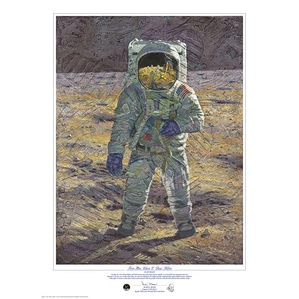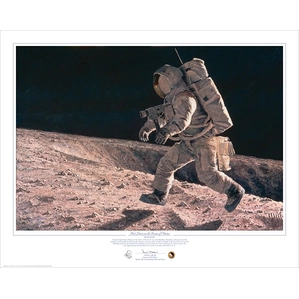Alan Bean A Window on the End of an Era Giclee On Canvas
Status: Out Of Stock | Condition: New | Edition:Artist Proof Giclee On Canvas | Edition Size: Artist Proof of 20 | Dim:Image Size: 16" X 24" | Alan Bean| Item #: GWAB00062
Price: $ 0.00 USD..
No availability at this time. Be First to be notified once we have Alan Bean - A Window on the End of an Era in-stock
Countries We Ship To:
Alan Bean, a former Apollo 12 astronaut, transformed his firsthand experience of space exploration into stunning fine art paintings. As the only artist to have walked on the Moon, his work captures the textured surface of the lunar landscape, often embedding real moon dust and mission patches into his canvases. His impressionistic space paintings bring the Apollo era to life, showcasing astronaut moonwalks, celestial landscapes, and cosmic exploration from a perspective no other artist can provide. His limited edition space prints and original paintings remain highly sought after by collectors of space history art, making Alan Bean a pioneer in astronaut-inspired fine art.
A Window on the End of an Era. This Piece has been Hand-Signed by Astronaut/Artist Alan Bean. - GWAB00062
NOTES: Captain Alan Bean creates imagery from a perspective on the Apollo program no other artist can claim. And, it is that moonwalker experience that enables him to lace his paintings with details that could only be remembered by someone who was there. “The Apollo 17 crew, Gene Cernan, Ron Evans and Jack Schmitt, are busy configuring their spacecraft for transearth injection, a burn that will rocket them out of lunar orbit and on a trajectory safely back to Planet Earth,†Alan Bean explains. “If they had the time to look out the window, they might see what we see, the stark lifeless beauty of the Crater Leuschner, bathed in a beautiful blue tinted reflected earthlight, with the magnificent blue and white Earth appearing to slip behind the lunar horizon for the last time. But they dont, their focus is inside. “It is about 5PM at Mission Control in Houston, Texas, on December 16, 1972, where we were in the final phase of completing the boldest era of exploration in history. The Apollo 17 crews mantra had been ‘The End of the Beginning. Apollo had done its work, taking humans 240,000 miles from the shores of our home planet and setting the stage for future exploration. “But since this last glimpse 40 years ago, nobody has ventured further than 400 miles from Earth. Few of us realized then that humans would not return to the Moon to stay for a very, very long time. But when they do return, it will be on the shoulders of Apollo. “I know that someday a new energy and quest for exploration will emerge from the leaders of our great nation to reach once again for the Moon and beyond, goals technically within our grasp, but not yet captured by their spirit. As we witness the Earth-set on this last orbit of the Moon by humans, Apollos place in history was complete: our work as the new explorers was done and it was time to pass the torch to others to fulfill the promise of Apollo.†Captain Bean creates his original works of art using a unique technique allowing the viewer to actually sense vestiges of the 20th centurys most dramatic accomplishments. Pressed into the canvas surfaces are Captain Beans authentic lunar boot “moonprints,†impressions from a core tube-bit used to collect soil samples and marks from a hammer used to drive the staff of the American flag into the moons surface. Our Greenwich Workshop Fine Art Edition Giclee of "A Window on the End of an Era" beautifully captures this element of his trademark style and each is signed by Astronaut, Explorer, Moonwalker and Artist, Alan Bean..
A Window on the End of an Era Giclee On Canvas by Alan Bean
image Copyright © 2025 by Alan Bean

Gift Card Purchase
E-Gift Cards from The Collection Shop are the perfect way to gift art enthusiasts. Click below for more details!
Alan Bean bio
Captain Alan Bean was the lunar module pilot on Apollo 12, the fourth man to walk on the moon and commander of Skylab 2. "I am fortunate enough to have seen sights no other artist ever has," Bean says.
"I want my paintings to communicate an emotional experience in ways that photography cannot."
Captain Bean creates his original works of art using a unique technique allowing the viewer to actually sense vestiges of the 20th century s most dramatic accomplishments. Pressed into the canvas surfaces are Captain Bean s authentic lunar boot "moonprints," impressions from a core tube-bit used to collect soil samples and marks from a hammer used to drive the staff of the American flag into the moon s surface. Moon dust, trapped on the patches on the outside of his suit, makes its way onto each original as well.
Each print and canvas is an historical record of the lunar experience, as each is signed by moonwalker Captain Alan Bean, with most countersigned by other moonwalkers and astronauts.This may be your only chance to own such a visionary and historic celebration of man s greatest achievement. NASA was sometimes asked "Why not send an artist to the moon?" It turns out they did.
Alan Bean—Apollo XII astronaut, commander of Skylab II and artist—was born in 1932 in Wheeler, Texas. In 1950 he was selected for an NROTC scholarship at the University of Texas at Austin. In 1955, he was commissioned an ensign in the United States Navy.
Holder of eleven world records in space and astronautics, as well as numerous national and international honors, Alan Bean has had a most distinguished peacetime career. His awards include two NASA Distinguished Service Medals, the Yuri Gagarin Gold Medal and the Robert J. Collier Trophy. As part of the Apollo XII crew, he became the fourth of only twelve men ever to walk on the Moon. As the spacecraft commander of Skylab Mission II, he set a world record: 24,400,000 miles traveled during the 59-day flight. He has also launched himself successfully into a new career as an artist.
When he wasn t flying, Bean always enjoyed painting as a hobby. Attending night classes at St. Mary s College in Maryland in 1962, Alan experimented with landscapes. During training and between missions as a test pilot and astronaut, he continued private art lessons. On space voyages, his artist s eye and talent enabled him to document impressions of the Moon and space to be preserved later on canvas. His art reflects the attention to detail of the aeronautical engineer, the respect for the unknown of the astronaut and the unabashed appreciation of a skilled painter.
The space program has seen unprecedented achievements and Bean realized that most of those who participated actively in this adventure would be gone in forty years. He knew that if any credible artistic impressions were to remain for future generations, he must paint them now. "My decision to resign from NASA in 1981 was based on the fact that I am fortunate enough to have seen sights no other artist ever has," Bean said, "and I hope to communicate these experiences through art."
Bean s book Apollo: An Eyewitness Account which chronicles his first-person experience as an Apollo astronaut in words and paintings was received with critical and popular acclaim upon its publication in 1998.

Alan Bean First Men Edwin E. Buzz Aldrin Print - AB00071
..Layaway with 3 pymts of $0.00

Alan Bean Fast Times on the Ocean of Storms Print - AB00066
..Layaway with 3 pymts of $0.00








